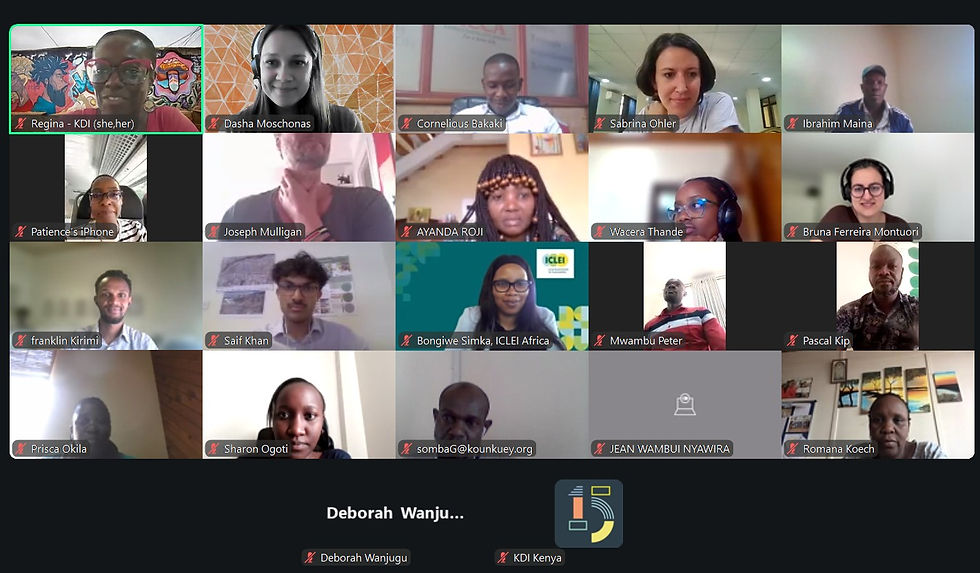Realising Urban Nature-based Solutions (r u NbS?) and Urban Natural Assets Teams Host Collaborative Session at RISE Africa 2025 in Cape Town
- Jun 11
- 2 min read
Updated: Jun 13
Cape Town, South Africa – 27 May 2025
At the RISE Africa 2025 Festival, the Realising Urban Nature-based Solutions (r u NbS?) team and ICLEI Africa’s Urban Natural Assets (UNA) programme co-hosted a joint session titled:“Leveraging Nature in an Urban Context: Lessons from Implementing Nature-Based Solutions and Collaborative Urban Design Processes.”
The session was co-facilitated by Regina Opondo (Kounkuey Design Initiative, r u NbS? team) and Sabrina Ohler (Project Manager, r u NbS?), and brought together urban practitioners, researchers, and decision-makers to explore how nature-based solutions (NbS) can be integrated into city planning and design to create more inclusive, resilient urban environments.
Bongiwe Simka (UNA team, ICLEI Africa) presented the UNA programme, sharing lessons from a decade of work supporting African cities to revitalise their urban natural assets. She highlighted the programme’s work in building local government capacity, conducting needs assessments, and facilitating city-to-city learning exchanges.
Kezia Ojal presented the r u NbS? programme, outlining its community-led approach to co-designing and implementing NbS for water management in informal settlements in Nairobi and Embu Town, Kenya. She detailed how the programme uses participatory processes, a monitoring and evaluation framework, and the Rivers + People planning model to embed NbS in underserved neighbourhoods.
Samson James Semakula, implementation partner from Entebbe, Uganda, presented the experience of implementing the UNA programme locally. His presentation offered insight into how NbS are being tailored to meet the urban challenges of Entebbe through collaborative, locally grounded approaches.
The session included a dynamic fishbowl discussion exploring key questions around:
Barriers and enablers of integrating NbS into urban planning
The role of community participation in shaping equitable, effective NbS
Strategies for scaling and sustaining NbS across diverse urban contexts
Reflections from the session:
Participants surfaced several key insights and provocations that will guide ongoing work in the region:
Redesigning cities at multiple scales—starting from the neighbourhood level—can catalyse citywide change, especially when municipal actors are on board.
Cities must be viewed through lenses that allow us to preserve, conserve, and tinker, constantly adapting to shifting social and ecological realities.
There is a need for intentional vernacularisation—creating inclusive, accessible spaces for dialogue. NbS must be framed not just in technical terms, but through a human rights lens that reaches those often excluded from planning conversations.
Language matters: it must build trust and support behaviour change. As Samson noted, consistent communication—through words and action—is key.
Data, data, data: robust evidence informs better planning and stronger advocacy. However, this must include community knowledge and informal urban realities to be meaningful and actionable.
Ownership is critical to success, particularly when working in informal settlements. Community members must see themselves in the process and outcomes.
NbS are not new or novel: as one participant noted, “Our ancestors walked with nature.” Rather than introducing foreign concepts, NbS can be framed as reconnecting with deep-rooted traditions of stewardship and interdependence. We are called not to forget our roots—and to carry forward this legacy wherever we are.
The session underscored the importance of inclusive design, institutional support, and cross-city collaboration in embedding nature into urban development. Through shared learning and practical implementation, both UNA and r u NbS? are supporting African cities to chart a more sustainable, climate-resilient, and people-centred urban future.




Comments